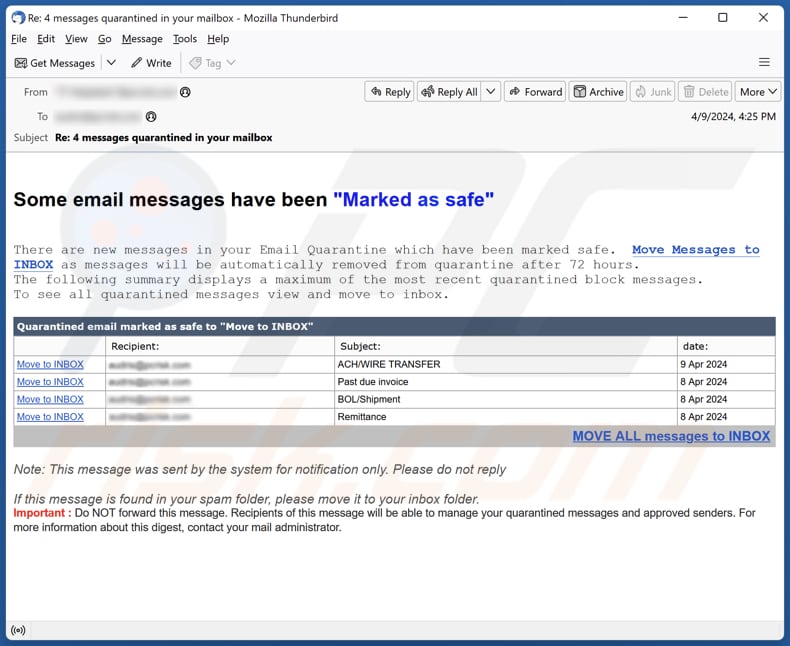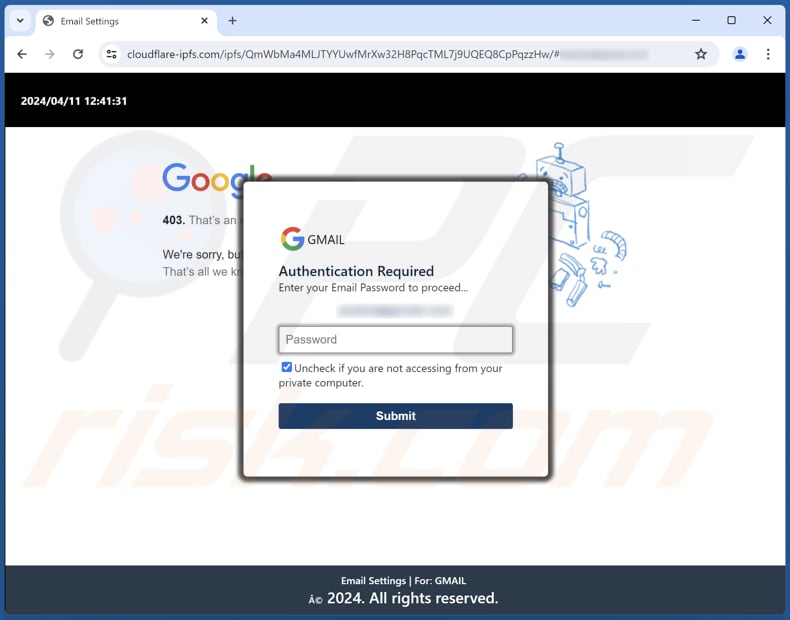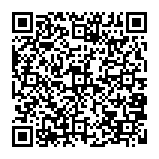How to identify scam campaigns like "Email Messages Marked As Safe"
![]() Written by Tomas Meskauskas on
Written by Tomas Meskauskas on
What is "Email Messages Marked As Safe"?
In our examination of the email, we have discovered that it is a phishing attempt disguised as a communication from an email service provider. Phishing emails are typically crafted to deceive recipients into revealing personal information. Moreover, cybercriminals often utilize such emails as a means to distribute malware.

More about the "Email Messages Marked As Safe" scam email
The phishing email appears to impersonate a notification from an email service provider. It falsely claims that certain messages have been marked as safe in the recipient's "Email Quarantine" and encourages them to move these messages to their inbox. The email lists several supposed quarantined messages, including subjects like "ACH/WIRE TRANSFER," "Past due invoice," "BOL/Shipment," and "Remittance," with corresponding dates.
It urges the recipient to move all messages to their inbox but warns against forwarding the email, stating that recipients could manage the quarantined messages and approved senders if forwarded. The email concludes with a note that it was sent for notification purposes only and advises against replying to it.
This email contains multiple hyperlinks labeled "Move Messages to INBOX", "Move to INBOX", and "MOVE ALL messages to INBOX". Clicking on these links redirects users to a phishing website designed to resemble the recipient's email service provider. For example, if the recipient uses Gmail, the fraudulent page will mimic the appearance of the Gmail site.
Once on the phishing page, users are prompted to enter their email account password to proceed. Apparently, scammers intend to deceive unsuspecting users into divulging their email account login credentials. Scammers exploit stolen email account credentials for various malicious purposes.
With access to an individual's email account, they can send out further phishing emails to the victim's contacts, spreading the scam to a wider audience. Additionally, they may attempt to access sensitive information stored within the email account, such as financial details, personal conversations, or login credentials for other online accounts.
Also, scammers often attempt to use the same login credentials to access other accounts associated with the victim, such as social media, banking, or shopping accounts. This allows them to further exploit the victim's personal information and financial assets for fraudulent activities.
| Name | Email Messages Marked As Safe Scam |
| Threat Type | Phishing, Scam, Social Engineering, Fraud |
| Fake Claim | Certain messages have been marked as safe |
| Disguise | Notification from an email service provider |
| Symptoms | Unauthorized online purchases, changed online account passwords, identity theft, illegal access of the computer. |
| Distribution methods | Deceptive emails, rogue online pop-up ads, search engine poisoning techniques, misspelled domains. |
| Damage | Loss of sensitive private information, monetary loss, identity theft. |
| Malware Removal (Windows) | To eliminate possible malware infections, scan your computer with legitimate antivirus software. Our security researchers recommend using Combo Cleaner. |
Similar scam emails in general
In conclusion, the phishing email discovered during our analysis exemplifies the deceptive tactics employed by cybercriminals to trick individuals into divulging sensitive information. By masquerading as a legitimate notification from an email service provider, the email aims to lure recipients into clicking on malicious links and disclosing their email account passwords.
This scheme underscores the importance of vigilance and skepticism when interacting with unsolicited emails, as well as the need for robust cybersecurity measures to safeguard against phishing attacks. Some examples of similar phishing emails are "Restore Email DNS", "Email Is Due For Renewal", and "WeTransfer - You Have Received Files".
How do spam campaigns infect computers?
Email is a common vector for malware distribution. Threat actors use malicious attachments or links to deliver malware. Their goal is to trick recipients into inadvertently triggering the malware through these deceptive elements. Once activated, the malware infiltrates the victim's device, potentially leading to data theft, system compromise, or other malicious activities.
Attachments in phishing emails can be executables (.exe), Microsoft Office documents (e.g., .doc, .xls, .ppt), PDF files, compressed archives (e.g., .zip, .rar), JavaScript files (.js), and other files.
How to avoid installation of malware?
Exercise caution when encountering email attachments or links, particularly those originating from unknown sources, to mitigate the risk of malware infection. Enhance your digital defenses by installing reputable security software and keeping your operating system, applications, and security tools up to date to guard against potential vulnerabilities.
When browsing the internet or downloading files, prioritize reputable sources like official websites and app stores to reduce the likelihood of encountering malicious content. Refrain from interacting with suspicious elements on questionable websites, including ads, alerts, and warnings, to minimize the risk of malware infiltration.
Avoid engaging with pirated software or tools designed to circumvent the activation of paid programs, as they often serve as vehicles for malware distribution. If you have already opened malicious attachments, we recommend running a scan with Combo Cleaner Antivirus for Windows to automatically eliminate infiltrated malware.
Text presented in the "Email Messages Marked As Safe" email letter:
Re: 4 messages quarantined in your mailbox
Some email messages have been "Marked as safe"There are new messages in your Email Quarantine which have been marked safe. Move Messages to INBOX as messages will be automatically removed from quarantine after 72 hours.
The following summary displays a maximum of the most recent quarantined block messages.
To see all quarantined messages view and move to inbox.
Quarantined email marked as safe to "Move to INBOX"
Recipient: Subject: date:
Move to INBOX ******** ACH/WIRE TRANSFER 9 Apr 2024
Move to INBOX ******** Past due invoice 8 Apr 2024
Move to INBOX ******** BOL/Shipment 8 Apr 2024
Move to INBOX ******** Remittance 8 Apr 2024
MOVE ALL messages to INBOXNote: This message was sent by the system for notification only. Please do not reply
If this message is found in your spam folder, please move it to your inbox folder.
Important : Do NOT forward this message. Recipients of this message will be able to manage your quarantined messages and approved senders. For more information about this digest, contact your mail administrator.
Screenshot of the phishing page utilized in this scam:

Instant automatic malware removal:
Manual threat removal might be a lengthy and complicated process that requires advanced IT skills. Combo Cleaner is a professional automatic malware removal tool that is recommended to get rid of malware. Download it by clicking the button below:
▼ DOWNLOAD Combo Cleaner
By downloading any software listed on this website you agree to our Privacy Policy and Terms of Use. To use full-featured product, you have to purchase a license for Combo Cleaner. 7 days free trial available. Combo Cleaner is owned and operated by Rcs Lt, the parent company of PCRisk.com read more.
Quick menu:
- What is Email Messages Marked As Safe phishing email?
- Types of malicious emails.
- How to spot a malicious email?
- What to do if you fell for an email scam?
Types of malicious emails:
![]() Phishing Emails
Phishing Emails
Most commonly, cybercriminals use deceptive emails to trick Internet users into giving away their sensitive private information, for example, login information for various online services, email accounts, or online banking information.
Such attacks are called phishing. In a phishing attack, cybercriminals usually send an email message with some popular service logo (for example, Microsoft, DHL, Amazon, Netflix), create urgency (wrong shipping address, expired password, etc.), and place a link which they hope their potential victims will click on.
After clicking the link presented in such email message, victims are redirected to a fake website that looks identical or extremely similar to the original one. Victims are then asked to enter their password, credit card details, or some other information that gets stolen by cybercriminals.
![]() Emails with Malicious Attachments
Emails with Malicious Attachments
Another popular attack vector is email spam with malicious attachments that infect users' computers with malware. Malicious attachments usually carry trojans that are capable of stealing passwords, banking information, and other sensitive information.
In such attacks, cybercriminals' main goal is to trick their potential victims into opening an infected email attachment. To achieve this goal, email messages usually talk about recently received invoices, faxes, or voice messages.
If a potential victim falls for the lure and opens the attachment, their computers get infected, and cybercriminals can collect a lot of sensitive information.
While it's a more complicated method to steal personal information (spam filters and antivirus programs usually detect such attempts), if successful, cybercriminals can get a much wider array of data and can collect information for a long period of time.
![]() Sextortion Emails
Sextortion Emails
This is a type of phishing. In this case, users receive an email claiming that a cybercriminal could access the webcam of the potential victim and has a video recording of one's masturbation.
To get rid of the video, victims are asked to pay a ransom (usually using Bitcoin or another cryptocurrency). Nevertheless, all of these claims are false - users who receive such emails should ignore and delete them.
How to spot a malicious email?
While cyber criminals try to make their lure emails look trustworthy, here are some things that you should look for when trying to spot a phishing email:
- Check the sender's ("from") email address: Hover your mouse over the "from" address and check if it's legitimate. For example, if you received an email from Microsoft, be sure to check if the email address is @microsoft.com and not something suspicious like @m1crosoft.com, @microsfot.com, @account-security-noreply.com, etc.
- Check for generic greetings: If the greeting in the email is "Dear user", "Dear @youremail.com", "Dear valued customer", this should raise suspiciousness. Most commonly, companies call you by your name. Lack of this information could signal a phishing attempt.
- Check the links in the email: Hover your mouse over the link presented in the email, if the link that appears seems suspicious, don't click it. For example, if you received an email from Microsoft and the link in the email shows that it will go to firebasestorage.googleapis.com/v0... you shouldn't trust it. It's best not to click any links in the emails but to visit the company website that sent you the email in the first place.
- Don't blindly trust email attachments: Most commonly, legitimate companies will ask you to log in to their website and to view any documents there; if you received an email with an attachment, it's a good idea to scan it with an antivirus application. Infected email attachments are a common attack vector used by cybercriminals.
To minimise the risk of opening phishing and malicious emails we recommend using Combo Cleaner Antivirus for Windows.
Example of a spam email:

What to do if you fell for an email scam?
- If you clicked on a link in a phishing email and entered your password - be sure to change your password as soon as possible. Usually, cybercriminals collect stolen credentials and then sell them to other groups that use them for malicious purposes. If you change your password in a timely manner, there's a chance that criminals won't have enough time to do any damage.
- If you entered your credit card information - contact your bank as soon as possible and explain the situation. There's a good chance that you will need to cancel your compromised credit card and get a new one.
- If you see any signs of identity theft - you should immediately contact the Federal Trade Commission. This institution will collect information about your situation and create a personal recovery plan.
- If you opened a malicious attachment - your computer is probably infected, you should scan it with a reputable antivirus application. For this purpose, we recommend using Combo Cleaner Antivirus for Windows.
- Help other Internet users - report phishing emails to Anti-Phishing Working Group, FBI’s Internet Crime Complaint Center, National Fraud Information Center and U.S. Department of Justice.
Frequently Asked Questions (FAQ)
Why did I receive this email?
Phishing emails are typically sent to a wide range of recipients with the aim of deceiving recipients into revealing sensitive information or performing other actions. Receiving a phishing email is often a result of cybercriminals casting a wide net in their attempts to exploit unsuspecting individuals.
I have provided my personal information when tricked by this email, what should I do?
Promptly update the passwords for any email accounts you may have compromised. Additionally, notify your email provider about the phishing attempt.
I have downloaded and opened a malicious file attached to an email, is my computer infected?
If the file is an executable, it is likely that your system has been infected with malware. However, if it is a document like a PDF or Word file, you may have avoided infection. Opening these types of documents does not always lead to computer infections.
I have read the email but did not open the attachment, is my computer infected?
Simply opening an email is typically safe. However, engaging with its contents, like clicking links or opening attachments, can put your system at risk of infection.
Will Combo Cleaner remove malware infections that were present in email attachment?
While Combo Cleaner effectively handles many known malware types, some more advanced threats may still hide deep within your system. Thus, conducting a full system scan is essential to ensure thorough detection and elimination of all threats.


▼ Show Discussion